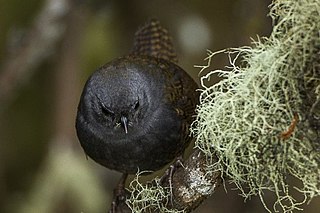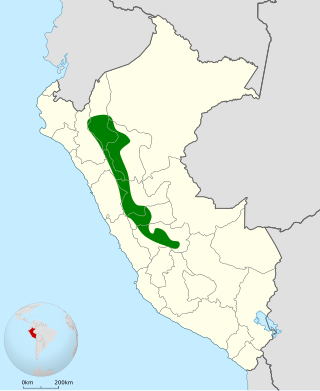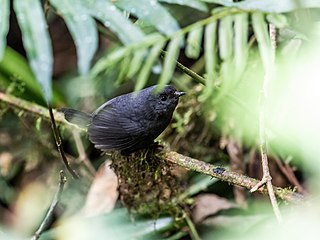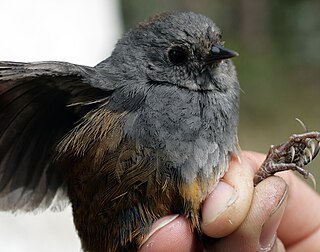
The blackish rail is a species of bird in the subfamily Rallinae of the rail, crake, and coot family Rallidae. It is found in Argentina, Brazil, Colombia, Ecuador, Paraguay, Peru, Venezuela, and possibly Bolivia.

The rusty-belted tapaculo is a species of suboscine passerine bird in the tapaculo family Rhinocryptidae. It is the only species placed in the genus Liosceles. It is found in Brazil, Bolivia, Colombia, Ecuador, and Peru.

Tschudi's tapaculo is a species of bird in the family Rhinocryptidae. It is endemic to Peru.

The Bolivian tapaculo is a species of bird in the family Rhinocryptidae. It is found in Bolivia and Peru.

The Paramo tapaculo is a species of bird in the family Rhinocryptidae. It is found in the Andes of Ecuador and southern Colombia.

The rufous-vented tapaculo is a species of bird in the family Rhinocryptidae. It is endemic to Peru.

The pale-bellied tapaculo, also known as the matorral tapaculo or rufous-rumped tapaculo, is a species of bird in the family Rhinocryptidae. It is found in Colombia and Venezuela.

The blackish tapaculo is a species of bird in the family Rhinocryptidae. It is found in Colombia, Ecuador, Peru, and Venezuela.

The Mérida tapaculo is a species of bird in the family Rhinocryptidae. It is endemic to Venezuela.

The long-tailed tapaculo is a species of bird in the family Rhinocryptidae. It is found in the eastern Andes of Colombia, Ecuador and far northern Peru.

The trilling tapaculo is a species of bird in the family Rhinocryptidae. It is found in Bolivia and Peru.

The Santa Marta tapaculo is a species of bird in the family Rhinocryptidae. It is endemic to the Sierra Nevada de Santa Marta of Colombia.

Spillmann's tapaculo is a species of bird in the family Formicariidae. It inhabits the Andes of Colombia and Ecuador.

The Nariño tapaculo is a species of bird in the family Rhinocryptidae. It is found in Colombia and Ecuador.

The mountain wren is a species of bird in the family Troglodytidae. It is found in the Andes of northwestern Argentina, Bolivia, Colombia, Ecuador, Peru, and western Venezuela.

The yellow-vented woodpecker is a species of bird in subfamily Picinae of the woodpecker family Picidae. It is found in Colombia, Ecuador, Peru, and Venezuela.

The Vilcabamba tapaculo is a small passerine bird in the family Rhinocryptidae. It is endemic to Peru.

The Perijá tapaculo is a species of passerine bird in the family Rhinocryptidae (tapaculos). Endemic to the Serranía del Perijá mountain range on the Colombia–Venezuela border, the Perijá tapaculo is found at altitudes of 1,600–3,225 metres. Its body is 10 to 12 centimetres long and its tail is about 4 cm (1.6 in) long. Specimens have long been stored in museums, but the species was described only in 2015 based on sixteen specimens found between July 2008 and February 2009. It is considered vulnerable to extinction.

The white-winged tapaculo is a species of bird in the tapaculo family, Rhinocryptidae. It was described in 2020 by the American ornithologist Tom Schulenberg and his colleagues. It is known only from north-central Peru, where it inhabits wet shrub forest and montane forest. White-winged tapaculos are small and drab birds, being mostly gray in color with brownish, barred upperparts and tails, and a distinctive patch of white on the wing. Adults are 10–11 cm (3.9–4.3 in) long; males weigh 18.0–20.8 g (0.63–0.73 oz) and females weigh 16.5–18.0 g (0.58–0.63 oz). Despite their relatively distinctive appearance, their cryptic nature means that they are typically best identified by their vocalizations.

The Loja tapaculo is a species of bird in the family Rhinocryptidae that the South American Classification Committee of the American Ornithological Society (AOS) accepted as a new species in July 2020. It had been classified as a subspecies of paramo tapaculo. It is found in Ecuador and Peru.





















